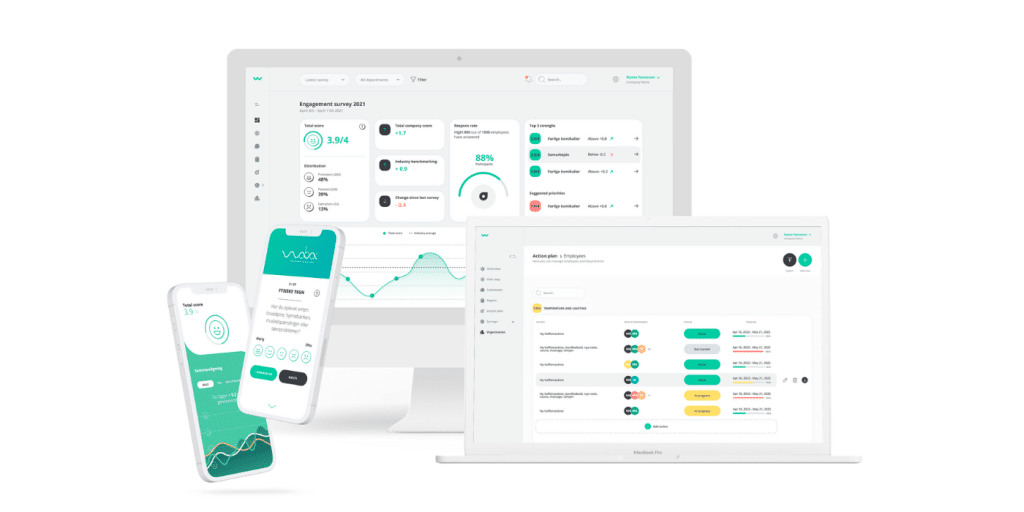In recent years, our exposure to quantitative employee surveys have increased – which also applies to the organizational field of research. The rise in digital survey platforms and easier distribution methods has led to more frequent workplace survey invitations, but it’s also caused a drop in the response rate.
This leads to Survey Fatigue:
“When respondents lose interest in your surveys because of the overwhelming frequency of survey requests or the extensive effort and questions involved in completing them.”
This, in turn, can create unfortunate barriers to the validity and representativeness of your engagement surveys in general. As employee engagement surveys gain increasing popularity, the quest for high response rates and valuable insights presents growing challenges. Organizations seek to assess their employees’ work life, but these hurdles cannot be ignored.
In this article, we’ll unveil the concept of survey fatigue and provide strategies to combat this silent adversary of quantitative research designs.
What are the main risks about Survey Fatigue?
When it comes to employee engagement surveys, there are a couple of key issues related to survey fatigue that you should be aware of.
- First, you might run into a problem of nonresponse. This means that some employees may not participate, which can affect the accuracy of your insights and your ability to make general conclusions.
- Second, you could end up with data that’s not entirely reliable because tired participants might hurry through the survey, giving quick answers without really paying attention to the questions.
The factors contributing to declining response rates
There are several factors contributing to declining response rates.
Firstly, there’s a proliferation of surveys, as more and more companies and organizations use them to gather opinions. This, along with the growing number of survey service providers and an increasing interest in data-driven decision-making, is causing what we call survey fatigue.
Another important point is that people who don’t respond to surveys are often more likely to contemplate leaving their jobs and generally report lower job satisfaction and less contentment with their supervisors compared to those who do respond.
What this means is that if a company’s HR department doesn’t receive feedback from these dissatisfied individuals, the data they collect may not accurately represent the reality. It could provide a more positive but inaccurate picture of the situation.
Lack of communication and followed actions from surveys triggers fatigue!
A research review performed by McKinsey showed that the number one driver of survey fatigue among participants is when they believe the organization won’t take any action based on the survey results.
On the flip side, when organizations not only run employee engagement surveys but also actively share relevant information and take appropriate actions based on the feedback, it encourages more employees to take part in current and future surveys.
Clearly, the crucial takeaway here is that employee surveys should be seen as a tool for making meaningful improvements, not just a metric by itself.
What can HR do to ensure better response rates?
Regardless if you are planning on conducting multiple surveys or just want to keep it once or twice over the course of a year, you need to embrace what is already known about survey fatigue:
- The idea of having multiple surveys can make people less likely to respond. That’s why it’s crucial to explain the purpose before sending out surveys in the first place (see point 3 below).
- People who don’t respond often mention time as a reason. This suggests that as the time spent on surveys increases, nonresponse becomes more common.
- The impact of survey fatigue can be reduced by making the survey content more relevant.
- The number of previous surveys might affect how people respond to the current one, although the evidence on this is mixed.
Balancing Purpose, Length, and Frequency in Employee Surveys
In short, long and time-consuming surveys without a clear purpose or relevance can potentially lower your response rate and the quality of the information you collect. This information is vital for making data-driven decisions for your employees.
But does this mean that surveys can’t be long? Does it mean that surveys have to be conducted in a less frequent manner, like once a year or every six months? And does this mean that, for example, employee pulse surveys are off the grid?
Not at all, to all of these questions.
What it means is that you need to align your communication about the purpose, length, frequency, and the follow-up actions based on the insights. If you plan to send out engagement surveys to your employees every month, make sure to explain why. Be ready to strike a balance between survey length and frequency because all burdens have limits, no matter how noble your intentions and follow-up actions are.
Do you want to measure engagement in your company? Download our free guide!
What we know from length and response rate in our platform
In Woba, we see our clients conducting surveys in a great variety-mix between length and frequency; some do short pulse surveys with as few as six questions every month, others do up to 100+ questions on an annual basis. Some mixes up two larger surveys (around 35-40 questions) twice a year, while others composes a mix of one larger annual survey along with more frequent pulses.

But what does this mean for survey response rates? Does the number of questions significantly affect response rates, or is it the survey frequency that plays a more crucial role?
Lets begin with insights from the Woba platform:
- The average number of questions in surveys from our clients is just about 50 questions.
- The average completion rate of the surveys is 80,2 percent (well done!)
- The average conducted number of surveys per organization is 3,4 – as shorter, pulse surveys are being more implemented in the strategic HR and management agenda.
- The average number of employees invited to participate in the surveys are 191,6 – the smallest number being 9 and the largest being 2524.
Surely, we are most interested in predicting the completion rate, as high completion rates are a key indicator of avoiding survey fatigue.
To do this, we investigated whether the number of survey questions (length) and survey frequency could predict a decrease in completion rates, taking into account factors like company type, year, and the type of survey (e.g., EHS survey, management evaluation survey, or engagement survey).
Interestingly, we didn’t discover any evidence to support the idea that the number of survey questions or the frequency of surveys had a statistically significant impact on response rates.
However, we did uncover an intriguing trend in the data:
Companies with a larger number of employees had lower response rates in their surveys. It appeared that the larger the company, the more challenging it was to achieve higher response rates.
Features in Woba that benefits high response rates
It’s important to acknowledge that our customers’ survey completion rates are consistently impressive, averaging around 80 percent. We don’t take sole credit for this success, as HR departments play a significant role in the survey process, both before, during, and after the surveys are conducted.
Nonetheless, Woba provides a range of features that make it even easier for employees to participate and share their work-related experiences:
- We are accessible through a browser and an app
- We automatically send out invitations and reminders to participate in the survey with the option to customize the communication.
- We have made it possible for everyone to participate with our Kiosk-solution – so even if the employee does not have a work-email, they are still able to sign up and join the survey (especially valuable to “blue-collar-workers”).
- We assist everyone in making the questions simple and understandable in terms of the formulations, without bringing the meaning of the question in jeopardy – hands-on support from our specialists.
Want to increase your survey response rate?
Woba’s vision is to create a better world to work in by revolutionizing your HR landscape.
Using Woba, you can transform employee surveys into proactive action plans, measure the ROI of your initiatives, and align them with your most crucial HR KPIs.
Schedule a meeting with me, and we can delve into how Woba can assist you in boosting survey completion rates and turning insights into proactive action plans for mitigating the risks associated with talent loss and absenteeism.












